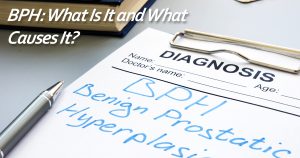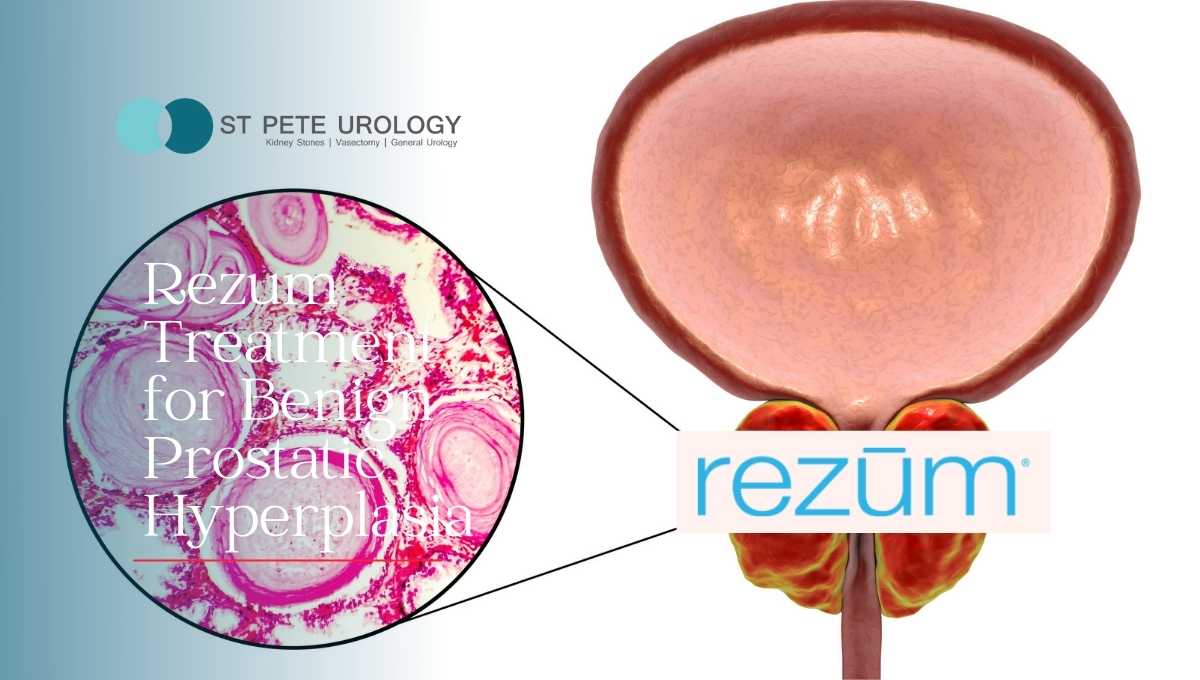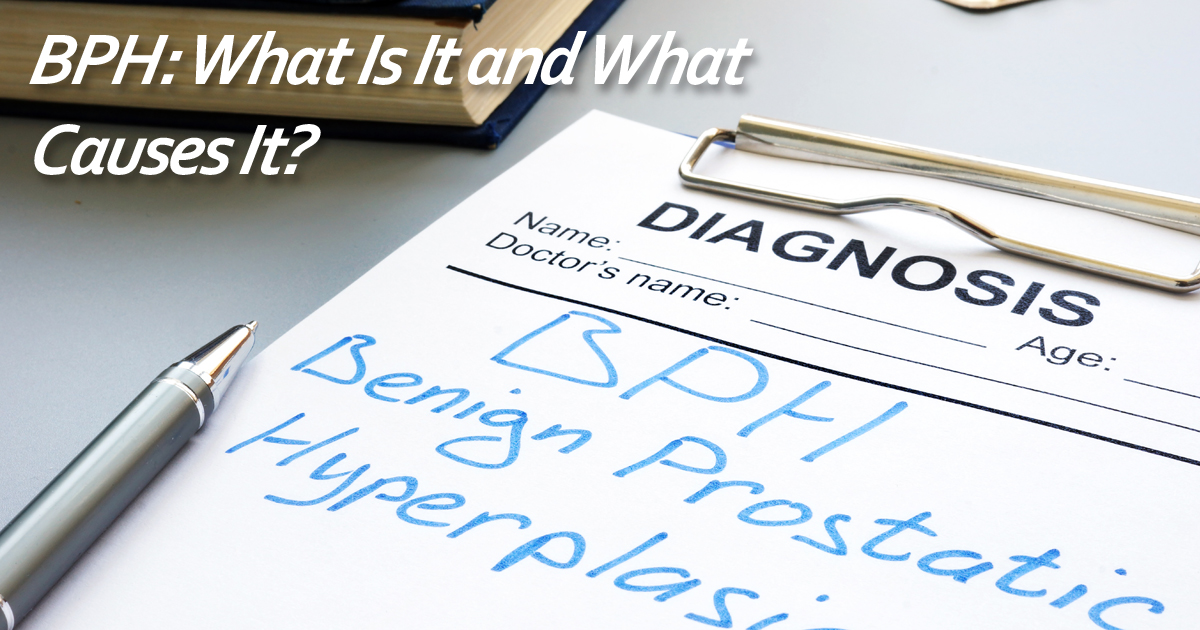Benign prostatic hyperplasia (BPH), also called enlarged prostate, is a frustrating condition commonly occurring as men grow older.
Continue reading7 Tips for Keeping a Healthy Prostate


All men, no matter their age, can find themselves dealing with a prostate issue, which is why every man should be concerned about his prostate health. Fortunately, there are easy ways to prevent or reduce the risk of developing prostate health problems.
Here are 7 tips for keeping your prostate healthy:
1. Eat more fruits and vegetables
Fruits and vegetables are great sources of anti-inflammatory and anticancer compounds, such as polyphenols, antioxidants, minerals, vitamins and fiber. Plants that boost prostate health are plentiful and include favorites such as tomatoes, broccoli, cauliflower, bok choy, cabbage, Brussels sprouts, pink grapefruits, watermelons, papaya and guava. Equally powerful are green leafy vegetables like spinach, lettuce, spring mix and kale which contain cancer-killing ingredients such as folic acid, vitamin D, turmeric and curcumin. Be sure to add fruits and vegetables to your everyday meals to boost your prostate health!
2. Eat more plant proteins and cut down on animal fat
You should avoid diets that are high in animal fat, including dairy products and red meat. Heavy consumption of red meat increases your risk of prostate cancer. So go for lean proteins, such as fish and chicken, but avoid grilled meat since grilling produces carcinogens that can inflame your prostate. Instead try baking, steaming, or broiling your meat.
High animal fat intake reduces antioxidant production in the body. And since it is the antioxidants that help to maintain a healthy prostate, excess fat diminishes prostate health. A good option for a healthy prostate is fish, which contains omega-3 acids that minimize the risk of prostate problems. Fish such as tuna, herring or salmon are good choices, but if fish is not your thing, then walnuts and flaxseed can be great sources of omega-3 acids.
Ideally, you should go for whole, natural foods that provide a lot of fiber. Soy is also good for your prostate and you can get it through sources like soy nuts, soy flour or tofu. Likewise, you should eat foods rich in selenium such as wheat germ, tuna, beef liver, eggs, sunflower, cashews, sesame seeds, mushrooms, onions, garlic and kidneys. Selenium boosts prostate health and minimizes the risk of prostate cancer.
3. Achieve a healthy weight
Obesity has been associated with various prostate health issues, including prostate cancer. If you are overweight, cutting back your weight, particularly abdominal fat, reduces the risk of BPH. In fact, if you desire to shrink your prostate size and get relief from annoying urinary symptoms, weight loss is valuable. Weight loss also helps reduce the risk of prostate cancer and relieves prostatitis.
4. Regular exercise
Moderate or vigorous activity minimizes the risk of BPH, urinary tract symptoms and prostatitis. Regular exercise also decreases stress, releases tension, improves immune function and maintains healthy hormone levels, all of which are important for a healthy prostate.
Aim for at least 30 minutes of moderate or intense physical activity every day. Try walking, swimming, running or bicycling, and make sure your exercise routine is not boring by varying your activities and even inviting friends to join you.
5. Drink tea
Both green tea and hibiscus tea contain potent antioxidants. Studies show that regular intake of tea helps with prostatitis, BPH and prostate cancer. Green tea also slows down the growth of aggressive prostate cancer.
Make sure to choose caffeine free sources of tea since caffeine irritates both the prostate and bladder and worsens symptoms of prostatitis. As a measure to cut down on caffeine intake, make sure to reduce energy drinks, coffee and soda.
Like tea, water is also great for the prostate. Drinking plenty of water will help you remain hydrated and enjoy normal prostate function. Make sure to drink at least 8 glasses of water every day, and to increase water intake during and after exercise.
6. Avoid smoking
Smoking affects every cell in your body. In fact, when cigarettes are burned, they are complete carcinogens. While smoking has less effect on low-grade or benign prostate cancer, it increases the risk of fatal prostate cancer. The heaviest smokers have 24-30 percent higher risk of death from prostate cancer than non-smokers. Smoking also increases the risk of prostate cancer progress after diagnosis.
Studies also show that smoking indirectly promotes benign prostatic hyperplasia (BPH) and increases prostate inflammation. Apart from smoking, alcohol use and inadequate sleep may adversely affect your prostate health. Also, a healthy sex life is good for your prostate.
7. Talk to your doctor
Do you have family history of prostate cancer? Let your doctor know. Remember that having a father or brother who has had prostate cancer more than doubles your risk of developing the disease. Speak with your doctor about your risk of prostate issues and explore the medical screening tests you should undergo as you age, follow dietary recommendations and be alert to any risk factors.
If you intend to begin a new exercise program, make sure to inform your urologist about it. Your doctor should know if you are experiencing symptoms such as:
- Discomfort or pain anywhere in your rectal or pelvic area
- Blood in your urine or semen
- Difficulty or pain when urinating
Are you or your loved one suffering from a prostate problem? St Pete Urology offers specialty urology services in a state-of-the-art facility and surgery center in St. Petersburg, Florida. We provide the latest innovations in surgical techniques and medical technology, delivering comprehensive care to those with urologic conditions. For more information about the prostate gland, BPH and prostate cancer, visit the St Pete Urology website.
How do you keep your prostate healthy?


The prostate is also the organ where the most common form of cancer for men develops. This cancer affects many men and the chances of developing it increase with age. The prostate also grows in size as men age. The rate and side effects of this growth can vary, but the most common symptoms are difficulty urinating and having to urinate frequently.
Given the importance of the prostate’s role and how easily it can develop problems, good prostate health is important. Luckily, there are simple lifestyle changes that can help improve prostate and overall health. These changes start with diet and exercise. There is a great deal of evidence that diet can help determine prostate health as well as cancer risk. It is recommended to have at least five servings of fruits and vegetables a day. Whole-grain bread and pastas are also recommended.
Protein is an important food group and eating the right kinds of protein plays a big role in prostate health. It is recommended to limit the intake of red and processed meats. Healthier sources of protein include fish, chicken, beans and eggs. Like protein, consuming the right fats is important, too. Healthy fats from olive oil, nuts, and avocados are much better than fats from animal byproducts or the trans fats found in fast food.
Sugar, salt and exercise play a role in prostate health as well. Sugary drinks like soda should be limited or cut out completely. Sweets in general should be an occasional treat, not a food group in your diet. Salt intake should be cut down for prostate health and keep in mind that most processed foods are very high in salt content.
Exercise is also important for maintaining good prostate health. There is evidence that regular exercise helps bring down the risk of stroke, heart disease and certain types of cancer.
Small changes to diet and exercise can add up to big health improvements, but there is still more you can do. Another important tool in keeping your prostate healthy is having a good relationship with your urologist. Yearly prostate exams and an open dialogue with a trusted urologist is key to maintaining prostate health and resolving issues early, before they turn into serious health problems. The urologists at St Pete Urology are dedicated to helping you keep your prostate healthy.
BPH: What Is It and What Causes It?


It is important to note that the size of the prostate does not necessarily correlate to the enlargement of the prostate. For instance, some men may have prostates that are only slightly enlarged and still suffer from symptoms worse than men with far greater enlarged prostates.
The prostate gland is found just below the bladder, and the tube that allows urine to exit the body runs directly through it. This is why urine flow is affected when the prostate enlarges. The primary cause of BPH is not fully known, but it may be related to changing sex hormone levels in men as they age.
The main risk factor for BPH is aging. Although BPH rarely affects men under 40, one-third of men between the ages of 40 and 60 experience it. And half of men experience it by age 80. Family history also plays a role in your chances of developing these problems. Men with a blood relative with BPH are more likely to develop it themselves. Diabetes, heart disease and obesity all increase the risk factors as well, while exercise helps lower them.
There are several complications that can result from BPH. The most common one is the inability to urinate, which may require a catheter if severe enough. Urinary tract infections can occur as well. Bladder stones and bladder damage may occur when the bladder cannot be fully emptied, which is more likely to happen to someone with BPH. Kidney damage is another complication that occurs when pressure that has built up in the bladder directly damages the kidneys.
Although common, BPH is a serious condition that can negatively affect quality of life and well being. But with many treatment options available, men can find relief by promptly seeking medical help. The doctors at St Pete Urology specialize in treating these issues and improving the lives of men as they age. For more information, visit the St Pete Urology website or make an appointment for a consultation.
Prostate Cancer: Symptoms and Signs
What is Prostate Cancer?
Prostate cancer only affects men because it occurs in the prostate, a small gland located below the bladder that produces the male seminal fluid to nourish and transport sperm.
What Are The Symptoms of Prostate Cancer?
Some cases of prostate cancer are silent. However, there are signs that might indicate the condition:
- Urinary and Other Problems:
- difficulty starting or maintaining a steady stream of urine
- frequent urination and leakage of urine
- excessive nighttime urination urge
- leaking small amounts of urine
- weak urination stream or straining to empty the bladder
- blood in the urine or seminal fluid
- onset of erectile dysfunction
- discomfort when sitting
Risk factors
Factors that may increase your risk of prostate cancer include:
- Age
- Family history
- Race
- Obesity
Prostate cancer is one of the most common types of cancer affecting men. When detected early and still contained to the prostate gland, it usually grows slowly. When initially confined to the prostate gland, it may not cause major harm. Prostate cancer that has been detected early has a better chance of successful treatment.
Treatment and Diagnosis
If you or your loved one is experiencing the signs or potential risk factors, it is best to make an appointment with a urologist. The urologist can take a biopsy, which is the only sure way to know if you have cancer. Additional steps that your doctor may employ include:
- A PSA test
- A DRE (this is a manual exam)
- Biomarker tests
Like any cancer, early detection and intervention are key to resolving it. If not caught and treated early, the cancer can metastasize or spread.
Untreated, prostate cancer can spread to nearby organs such as the bladder, or to the bones or other organs, through your bloodstream or lymphatic system. If prostate cancer reaches the bones, it can cause pain and broken bones. As prostate cancer advances, it can be treated and somewhat controlled but it is unlikely to be cured at a later stage.
Prostate Cancer Prevention
Doctors recommend the following changes to prevent prostate cancer. These recommendations are healthy lifestyle changes for all individuals:
- Choose a healthy diet full of fruits, vegetables and whole-grain foods.
- Avoid high-fat foods.
- Exercise at least 3 to 4 times a week.
- Maintain a weight that is healthy for your body mass.
Men who face a higher risk of prostate cancer may consider medications or other treatments. Your urologist may prescribe 5-alpha reductase inhibitors. Not only do these drugs reduce the overall risk of developing prostate cancer through controlling prostate gland enlargement, they also may reduce hair loss.
Many men would rather avoid prostate exams and knowing if they have prostate cancer. They may fear that if cancer is detected they will experience impotency or incontinence because of treatment. However, recent medical developments have made such concerns unnecessary. To learn more about prostate problems, visit the St Pete Urology website or make an appointment for a consultation.
How to tell if your prostate is enlarged?
The prostate gland is an integral part of the male reproductive system. It secretes seminal fluid, which nourishes sperm as they grow and facilitates their transportation during ejaculation. It is located between the bladder and the rectum and surrounds the base of the urethra. Due to its location next to key parts of the urinary system, the health of the prostate gland tends to have a direct impact on the health of a man’s urinary system.
The prostate gland grows larger as a man ages. While this gradual enlargement is normal, by the time a majority of men turn 50, the prostate has reached a size where it may start to affect the normal functioning of the urinary organs near it. It is at this point that a man is said to have an enlarged prostate, or clinically speaking, benign prostate hyperplasia (BPH).
Signs and Symptoms of an Enlarged Prostate
An enlarged prostate presses, pinches or causes a blockage in the urethra. The urethra carries urine from the bladder to outside the body. The direct effects of an enlarged prostate are manifested by difficulty in the discharge of urine. These difficulties could be in the form of:
1. Frequent and sudden urges to discharge urine;
2. Difficulty starting a urine stream;
3. Weak urine stream; and
4. Dribbling urine.
If left untreated, the effects of an enlarged prostate can cause the following complications:
1. Acute Urine retention. This is a complete inability to pass urine. Medical attention must be sought immediately if this occurs;
2. Urinary tract infections;
3. Blood in the urine;
4. Pain when passing urine; and
5. Pain in the lower abdomen.
Sometimes an enlarged prostate does not produce symptoms. When this occurs in some men, it may not even be possible to diagnose the condition because it gives them no trouble at all.
The key to diagnosing and treating an enlarged prostate lies with frequent prostate monitoring by a qualified urologist. Men approaching age 50 should get tested or at least keep a watch out for any of the symptoms listed above. The good news is there are many successful treatment options for the condition. Our specialists at St Pete Urology are experienced and well qualified to help with any questions, concerns and treatment. If you think you may have an enlarged prostate, or are experiencing any problems, by all means contact us. For more information, visit the St Pete Urology website.
What is a PSA Test and When Should You Get It?
What are the benefits of the PSA test?
Early detection of certain types of prostate cancer is critical for successful treatment and recovery. When the PSA test shows elevated levels of the antigen in blood, it may help to identify prostate cancer that is likely to grow quickly or spread to other parts of the body. In turn, the test helps to catch and treat such cancers early before they begin causing serious symptoms or become life-threatening. Also, by enabling early detection of prostate cancer when the necessary treatment is less aggressive, the test reduces the risk of certain adverse effects of treatment, such as urinary incontinence and erectile dysfunction.
What are the risks associated with the PSA test?
Carrying out the test itself comes with very little risk. It requires only a simple drawing of blood used to run the test in a laboratory. However, once the results of the test are out, there are a number of potential downsides involved. For instance, since false positives are quite common and elevated PSA results may have other causes other than prostate cancer, including prostate infection (prostatitis) and enlarged prostate (BPH), the test results may expose some patients to unnecessary or inappropriate treatments.
Some types of prostate cancer don’t produce much PSA, which means that a test may incorrectly indicate that you don’t have the cancer (a false negative). And follow-up tests for checking out the underlying causes of an elevated PSA test are often stressful, invasive, time-consuming or expensive. Furthermore, living with a localized or slow-growing prostate cancer — one that doesn’t require treatment — can cause stress and anxiety.
When should you get your first PSA test?
Before you get the first PSA test, it is recommended that you discuss the benefits and risks of the test with your doctor. During the discussion, a comprehensive review of your risk factors and preferences is done. For example, the urologist will consider your age, race, size of your prostate, medications you are taking (dutasteride and finasteride affect PSA levels), and how frequently your PSA levels change when making a decision about getting the test.
At St. Pete Urology, we advise men who are at higher risk of the disease, such as African American men and those with a brother or father who have had the cancer, to get their first test at the age of 40-45. Having the test before you reach 50 helps us to establish your PSA baseline and thereafter monitor the changes in your PSA levels to determine whether or not you’ll need annual PSA screening and prostate biopsy. If your blood PSA level is very low, we’ll put off any further PSA tests. But if you are a man of moderate to low risk of the disease, we recommend you get your first PSA test at age 50 or older (generally between 55 and 70).
What happens if your first PSA test result is high?
If you don’t have symptoms of prostate cancer, another PSA test may be recommended if your first test showed an elevated PSA level. The second test is used to confirm the validity of the original finding. But if the second PSA test still gives elevated PSA level, the urologist may direct that you continue with more PSA blood tests and digital rectal exams (DREs) at frequent intervals to monitor any changes in your prostate over time.
If your blood PSA level continues to rise over time or the urologist finds a suspicious lump in your prostate during a DRE, additional tests may be suggested to establish the nature of the problem. For example, a urine test may be run to find out if you have a UTI (urinary tract infection). Imaging tests like X-rays, cystoscopy or transrectal ultrasound also may be recommended. Then if prostate cancer is suspected, the urologist carries out a prostate biopsy — collecting multiple samples of tissue from your prostate by inserting hollow needles into the gland and withdrawing tissue. The tissues are examined under a microscope by a pathologist to confirm the cancer.
Treatment of prostate cancer
The type of treatment recommended for prostate cancer usually depends on whether it is early-stage or advanced-stage disease. For early-stage cancer the options include watchful waiting, radical prostatectomy, brachytherapy, conformal radiotherapy and intensity-modulated radiation therapy. At St Pete Urology, watchful waiting means no immediate treatment is offered but the cancer is closely monitored through regular PSA tests. Prostatectomy involves surgically removing part of or the entire prostate; brachytherapy involves implantation of radioactive seeds into the prostate to deliver specific amounts of radiation to the tumor. Conformal and intensity modulated radiotherapies deliver targeted amounts of radiation to the tumor with minimal damage or exposure of healthy tissues.
For advanced-stage prostate cancer, which is typically a more aggressive tumor that grows quickly and spreads faster to other areas of the body, treatment includes chemotherapy and androgen deprivation therapy. Chemotherapy can eliminate cancer cells that have spread to other parts of the body. Likewise, androgen deprivation therapy (androgen suppression therapy or ADT) is used to reduce the effect of androgens — male hormones that stimulate cancer growth — thereby slowing down or stopping cancer growth.
At St Pete Urology, we talk to our patients openly and candidly about the risks and benefits of the PSA test before we can advise them to get it. We also discuss the results of the tests, give our recommendations for those with positive results and typically repeat the PSA test for those with negative results. Our patients have always told us that our attention to detail, quality of interactions and efficiency during their visits is unmatched. If you would like to know more about the PSA test, visit the “St Pete Urology” site.
What kinds of prostate problems are common in men over 50?
Benign Prostatic Hyperplasia
With the prostate, there are usually two main issues: benign prostatic hyperplasia and prostate cancer. For men older than 50, benign prostatic hyperplasia (BPH) is the most frequent prostate issue. BPH, also called an enlarged prostate, means a non-cancerous increase in the number and size of prostate cells — so basically, it is an unhealthy increase in prostate size. While what triggers BPH isn’t well understood, it is believed that factors such as aging, inflammation, fibrosis and hormonal changes are the causes of the condition.
An enlarged prostate presses hard on the urethra and makes urination difficult. In men with the condition, symptoms include:
- Frequent urination, particularly at night.
- Difficulty starting a urine stream.
- Dribbling after passing urine.
- Weak urine stream, or a stream that starts and stops.
- Inability to empty the bladder completely.
But BPH also may have rare and more severe symptoms like:
- Urinary tract infection
- Blood in urine
- Inability to urinate
Prostate cancer
Prostate cancer is another frequent condition in men. In fact, it is the most common cancer after skin cancer, with about 1-in-6 American men being diagnosed with the disease during his lifetime. And like BPH, the cancer is most common in older men, with two-thirds of men diagnosed with the condition usually over age 65.
The cause of prostate cancer isn’t clear, but risk factors include age, family history, race and diet. The cancer grows slowly and rarely shows symptoms, so most men may never know that they have developed the disease until it is in advanced stage. But that also means only around 1-in-35 men with the cancer dies of the disease. Nevertheless, while some prostate cancers grow slowly and often require no or minimal treatment, there are other types that are quite aggressive and spread really quickly.
When caught early, there is a better chance of successfully treating the cancer. However, since it has similar symptoms to BPH, the condition is quite difficult to diagnose and by the time men see blood in their urine or feel chronic pain in their thighs, hips or lower back, it is often quite late. That is why it is critical for men of average to high risk of the cancer to have annual screening as early as appropriate.
Actually, for men of average risk of prostate cancer, the discussion to begin screening should start at the age of 50. While for those of higher risk, it is prudent to begin this discussion a little earlier, though not earlier than 40. But before screening, it is vital to discuss the risks and benefits of the testing with the doctor so the test offered meets the personal preferences and values of the patient.
For more information on prostate problems and how to prevent, diagnose and treat them, visit the “St Pete Urology” site.
What causes the prostate to enlarge?
Although the exact trigger of BPH (Benign Prostatic Hyperplasia) is not fully known and may vary from one man to another, there are risk factors that contribute to the condition. Benign prostate enlargement means your prostate grows in size without being cancerous. As the prostate swells and becomes bigger, it presses on your urethra and bladder and may cause a number of urinary and bladder function problems. The known contributing factors to prostate enlargement are age, hormones, stress levels and diet.
1. Age
Your age is a risk factor and not a cause of BPH. Prostate growth is considered a normal part of aging. In fact, the prostate usually goes through two major periods of growth as a man ages. During early puberty, the prostate doubles in size. Then from the age of 25 the gland enters a second phase of growth and continues to increase in size for the rest of his life. It’s typically during this second growth phase that benign prostatic hyperplasia occurs. About 50 percent of men over the age of 50 have BPH, while up to 90 percent of men over 80 years old have the condition.
2. Hormones
Hormones have a major role in triggering BPH. For instance, testosterone — the male sex hormone responsible for sexual development, muscle mass, deep male voice and libido — is converted to DHT (dihydrotestosterone) when it is in excess in the body. DHT is a useful hormone in adolescents because it ensures normal growth and development of sexual organs, including the prostate. But the production of excess quantities of DHT results in problems such as aggression and acne in adolescents. In older men, excess production of DHT causes the prostate to continue to grow and enlarge. If left unchecked, this could lead to an enlarged prostate and other problems associated with the gland.
3. Diet
Prostate enlargement is a more common problem in Western countries such as the U.S. and UK, but occurs in lower rates in Asian countries like Singapore and Japan because of dietary reasons. A typical Western diet contains simple carbohydrates, refined sugar, meat, dairy and unhealthy fats, while traditional Asian and Eastern diets are often richer in complex carbohydrates, vegetables and healthy soya-based proteins. The dietary differences are therefore critical for the varied incidences of BPH in the Western and Eastern countries.
The regular consumption of red meat escalates the risk of developing BPH by 38 percent, and regular dairy intake not only contributes to joint pain and hay fever through inflammation, but also inflames the prostate and accelerates the enlargement process. On the other hand, consuming 4 or more vegetable servings a day decreases the risk of BPH by 32 percent, and regular intake of soya reduces the chances of having an enlarged prostate. Likewise, zinc, commonly found in seeds and nuts and often missing in typical Western diets, is critical for a healthy prostate.
Poor diets lacking in fiber can cause constipation, which badly affects the prostate. The prostate is located very close to the bowels. If toxins remain in the bowels for a long time they start to leak into the surrounding tissues and into the prostate. When that happens, inflammation and pain may occur in the prostate. Similarly, the pressure caused by constipated bowels on both the bladder and prostate can worsen BPH symptoms.
4. Stress levels
Prolonged repeated exposure to stress, such as men who have high-pressure jobs, who commute frequently or who are rarely relaxed, can lead to or worsen BPH. For men already suffering the symptoms of an enlarged prostate, stress leads to inflammation of the prostate and worsens the symptoms. It also causes muscular tension, which results in further restriction of bladder function. Increased exposure to stress quickly depletes the body of nutrients and one of the most frequently stress exhausted nutrients is zinc, which is vital for prostate health. Repeated high stress levels also lead to increased secretion of testosterone and DHT hormones, which contribute to the growth of the prostate.
So what’s your role in preventing BPH?
You can’t do anything about your age, but you can do something about your lifestyle and diet to boost the health of your prostate. Start by avoiding or cutting down on dairy and meat, add lots of vegetables, fruits, nuts, seeds and whole grains to your nutrition regimen, and try including soya products like miso, tofu and tempeh in your diet. Initially that may be difficult if you are used to consuming meat and dairy-heavy meals. But by incorporating tasty, plant-based substitutes such as tofu, three-bean curry, mushroom risotto and vegetable satay, you can quickly get used to meals without meat and dairy. Take steps to reduce your stress levels by dealing with the underlying causes of your stress. Take a stress remedy, practice mindfulness or see a counselor — whatever works best for you.
For more information on prevention, diagnosis and treatment of BPH, visit the “St Pete Urology” site.
GreenLight PVP Laser, a Great Treatment Option for BPH
Photo-selective Vaporization of Prostate (PVP) is increasingly becoming a popular method of treating benign prostatic enlargement (enlarged prostate or BPH). Using a combination of a high-powered laser beam and fiber optics to vaporize overgrowths of cells in the prostate, PVP helps to shrink the prostate gland quickly and accurately and swiftly relieves symptoms of Benign Prostatic Hyperplasia. The GreenLight Laser PVP is an alternative to the more common TURP (Transurethral Resection of Prostate). While the PVP procedure offers equal effectiveness in improving BPH symptoms, it’s simpler, has minimal short-term side effects, and offers quicker symptom relief, comfort and ease of urine flow.
How Is The Procedure Performed?
Conducted as an outpatient procedure by a urologist trained in the technique, the GreenLight Laser PVP requires nerve-blocking, spinal or general anesthesia along with sedation. During the procedure, the urologist inserts a cystoscope (tube supplied with light) via the urethra into the prostate, then runs a thin fiber through the cystoscope and places it in the urethra just adjacent to the obstruction. The urologist directs the laser at the prostate with intense pulses of light radiating from the ends of the fiber that are absorbed by blood.
As the blood absorbs light its temperature increases rapidly, heating up and vaporizing nearby cells. The surgeon continues to apply the laser light to destroy tissue overgrowth and reduce restriction on the urethra. The tissue that’s evaporated seals the blood vessels and reduces bleeding. The procedure takes roughly 40-60 minutes and a temporary catheter is usually inserted to help drain urine from the bladder.
So what are the benefits of Laser PVP?
- Minimal bleeding.
- Patients return home the same day.
- Return to normal activities in 2-3 days with caution.
- Only about 30 percent of patients require a post-op catheter.
- Return to strenuous activities in 4-6 weeks.
- Complications are rare, but quite mild if they occur.
- No post-operative impotence.
- PVP has not been associated with erectile dysfunction.
- Less likely to cause retrograde ejaculation.
- Lasting improvement in urine flow.
- Urinary obstruction is less likely with PVP.
Recovery after GreenLight Laser PVP
After laser PVP, patients remain in a recovery area where they are observed and prepared for discharge, typically within a few hours. If a temporary catheter is inserted, it’s usually removed 2-3 days after treatment, but may be left for a longer period in men who have had very severe symptoms or suffered prior bladder damage. During the first week following the procedure, a slight burning and discomfort may be experienced when urinating and small amounts of blood may occur in urine. While a dramatic improvement of symptoms and urine flow occurs within 1-2 days after the procedure, patients may still experience frequency and a sudden urge to pass urine for some time after treatment since the urethra is still adjusting to changes. And those with multiple health problems may not realize improvement that quickly.
Many men resume normal activities three days or so after laser PVP, but it’s recommended that they refrain from heavy lifting, pushing, strenuous exercise and vibrating equipment for at least 2 weeks because such activities may aggravate the urogenital area and cause bleeding. Sexual activity should be avoided for 2-3 weeks and only resumed when the patient is really comfortable doing so. It’s crucial to take things slowly and realize that it’ll take a while to get everything back to normal, including sexual desire. At times, retrograde ejaculation or reduced volume may occur, but these do not affect sexual pleasure or orgasm.
Is Laser PVP Safe?
The GreenLight Laser PVP is a significant improvement on the other minimally-invasive procedures used to treat BPH. It accurately vaporizes the overgrowth of the prostate gland without damaging any surrounding tissues and vessels. High-powered energy beams are delivered through a very thin laser fiber resulting in safe and precise vaporization of the overgrown tissue that’s blocking normal urine flow. As the high-pulsed laser removes the tissue causing blockage, it coagulates blood vessels and minimizes bleeding. Compared to other options for treating BPH, the GreenLight Laser PVP is much safer, simpler, faster, more precise and more effective. And most importantly, it allows quicker recovery than the other treatment options.
How does laser PVP compare with TURP?
Previously, effective BPH treatment required open prostatectomy — a major abdominal operation that needed a longer hospital stay and several months for recovery. But with the availability of instruments for accessing the prostate via the urethra instead of through the abdomen, TURP (transurethral resection of prostate) became the preferred treatment as it offered more safety, efficiency and effectiveness. However, there was still need for a better treatment that could offer quicker results, shorter recovery times and fewer long-term side-effects. The GreenLight Laser PVP has proven an improvement on TURP by being less invasive, delivering more immediate results and providing shorter recovery periods.
At St Pete Urology, we recommend transurethral vaporization procedures, most commonly the PVP GreenLight Laser and HoLAP (Holmium Laser Ablation), as alternatives for the previous gold standard TURP (Transurethral Resection of Prostate) because they are minimally-invasive outpatient operations with lower risks, durable results, safe use on large glands and patients on blood thinners, and high patient satisfaction. We perform the PVP GreenLight Laser on patients eligible for TURP, but discuss all the treatment options with our patients before we make a choice. For more information on treatment and care for BPH, visit the “St Pete Urology” site.





